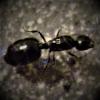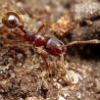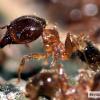- Formiculture.com
- Forums
- Gallery
- Members
- Member Map
- Chat

General concensus on keeping invasive ants?
Started By
Naturenut1233
, Mar 14 2018 7:50 AM
26 replies to this topic
#1
 Offline
-
Posted March 14 2018 - 7:50 AM
Offline
-
Posted March 14 2018 - 7:50 AM
So I understand not importing foreign queen ants, and it makes sense, but this may be a stupid question, but what about if you find a species that is not native to your area that is invasive? Can you keep it and just never release it / keep the colony till they die off or destoy them if you have to move? Or should you destroy the queen when you find her and not take the risk? I'm just trying to find out the morally right thing to do is. I am pretty sure I have a myrmica rubra queen that I found last summer, however until I actually confirm the ID, I've just been holding onto her. No brood or anything yet. What would you guys do?
My current ants species
Lasius Claviger
#2
 Offline
-
Posted March 14 2018 - 8:00 AM
Offline
-
Posted March 14 2018 - 8:00 AM
Naturenut1233, on 14 Mar 2018 - 3:50 PM, said:
So I understand not importing foreign queen ants, and it makes sense, but this may be a stupid question, but what about if you find a species that is not native to your area that is invasive? Can you keep it and just never release it / keep the colony till they die off or destoy them if you have to move? Or should you destroy the queen when you find her and not take the risk? I'm just trying to find out the morally right thing to do is. I am pretty sure I have a myrmica rubra queen that I found last summer, however until I actually confirm the ID, I've just been holding onto her. No brood or anything yet. What would you guys do?
well i know that myrmica rubra are established in the northeast, while they may be an invasive ant i don't personally see a problem with you keeping them if you catch them in the wild. i don't think they are as aggressive as say S. Invicta which has invaded a large portion of the south and spreads rapidly. If it were me i would keep them just for the purpose of studying and observation, but what you do is up to you
Colonies:
Founding:
Camponotus cf. Modoc
Camponotus cf. Herculeanus
Dream Ants:
Stenamma Diecki
Solenopsis Molesta
Manica Invidia
Camponotus Herculeanus
Lasius Latipes
Dorymyrmex Pyramicus
Tapinoma Sessile
#3
 Offline
-
Posted March 14 2018 - 8:50 AM
Offline
-
Posted March 14 2018 - 8:50 AM
As long as you don't release them, it's fine. Don't release naturalized or native ants either.
Edited by Martialis, March 14 2018 - 8:51 AM.
Spoiler
#4
 Offline
-
Posted March 14 2018 - 8:56 AM
Offline
-
Posted March 14 2018 - 8:56 AM
There isn't really a general consensus but most people won't have an issue with you keeping them as long as you don't sell or ship them.
There are some counties where keeping certain ants is forbidden though (like imported fire ants in parts of California) so doing some research might be a good idea, but as long as it's not one of the more "popular" invasive species (Solenopsis invicta, Argentines, Pheidole megacephala, Brachymyrmex patagonicus) you're probably on the safe side.
- Martialis and ZllGGY like this
We should respect all forms of consciousness. The body is just a vessel, a mere hull.
Welcome to Lazy Tube - My Camponotus Journal
#5
 Offline
-
Posted March 14 2018 - 8:59 AM
Offline
-
Posted March 14 2018 - 8:59 AM
Martialis, on 14 Mar 2018 - 4:50 PM, said:
As long as you don't release them, it's fine. Don't release naturalized or native ants either.
I agree. From what I understand, it's generally frowned upon to keep invasive ants, considering the potential release of a particularly damaging species. If you're relatively experienced and are able to control growth, I support it.
#6
 Offline
-
Posted March 14 2018 - 9:41 AM
Offline
-
Posted March 14 2018 - 9:41 AM
Thanks. I certainly no plans to release invasive species. 
- Martialis likes this
My current ants species
Lasius Claviger
#7
 Offline
-
Posted March 14 2018 - 10:05 AM
Offline
-
Posted March 14 2018 - 10:05 AM
Serafine, on 14 Mar 2018 - 4:56 PM, said:
There isn't really a general consensus but most people won't have an issue with you keeping them as long as you don't sell or ship them.
There are some counties where keeping certain ants is forbidden though (like imported fire ants in parts of California) so doing some research might be a good idea, but as long as it's not one of the more "popular" invasive species (Solenopsis invicta, Argentines, Pheidole megacephala, Brachymyrmex patagonicus) you're probably on the safe side.
I actually caught a B. patagonicus queen in a greenhouse conservatory here in Indiana, and have a few preserved queen Ph. megacephala specimens collected in Philadelphia. It really seems that nowhere is safe from invasive ants.
Spoiler
#8
 Offline
-
Posted March 14 2018 - 12:56 PM
Offline
-
Posted March 14 2018 - 12:56 PM
Martialis, on 14 Mar 2018 - 6:05 PM, said:
I actually caught a B. patagonicus queen in a greenhouse conservatory here in Indiana, and have a few preserved queen Ph. megacephala specimens collected in Philadelphia. It really seems that nowhere is safe from invasive ants.
Finding P. megecephala in Philadelphia would be big news, considering the northernmost latitude they have been found existing outdoors is 40 degrees N, and that in a city where it rarely snows (Barcelona). A colony had been found in Connecticut, but indoors, probably accompanying potted plants from lower down. Have you tried to ID your specimens? For workers, you can use this:
https://pheidolemega...t.com/p/ho.html
As to keeping invasive ants, if the species is already widespread in your locality (and is not prohibited like Wasmannia aurupunctata is in Hawaii), I doubt your keeping them would make much difference in the larger scheme of things.
Edited by kalimant, March 14 2018 - 1:00 PM.
I currently maintain a site dedicated to the hyper-diverse myrmicine genus Pheidole.:
I also own the Lurker's Guide to Leafcutters Ants
#9
 Offline
-
Posted March 14 2018 - 1:17 PM
Offline
-
Posted March 14 2018 - 1:17 PM
kalimant, on 14 Mar 2018 - 8:56 PM, said:
Martialis, on 14 Mar 2018 - 6:05 PM, said:
I actually caught a B. patagonicus queen in a greenhouse conservatory here in Indiana, and have a few preserved queen Ph. megacephala specimens collected in Philadelphia. It really seems that nowhere is safe from invasive ants.
Finding P. megecephala in Philadelphia would be big news, considering the northernmost latitude they have been found existing outdoors is 40 degrees N, and that in a city where it rarely snows (Barcelona). A colony had been found in Connecticut, but indoors, probably accompanying potted plants from lower down. Have you tried to ID your specimens? For workers, you can use this:
https://pheidolemega...t.com/p/ho.html
As to keeping invasive ants, if the species is already widespread in your locality (and is not prohibited like Wasmannia aurupunctata is in Hawaii), I doubt your keeping them would make much difference in the larger scheme of things.
They were indeed P. megacephala. They were on plants imported from Florida (in a greenhouse), so I don't think it's that big of news.
Spoiler
#10
 Offline
-
Posted March 14 2018 - 7:39 PM
Offline
-
Posted March 14 2018 - 7:39 PM
In my state Myrmica rubra is distributed in pockets along the coast with a few inland. Acadia National Park has quite a hot spot of them apparently. I know the state officials want to be notified of any colonies people find and they are trying to prevent their spread. I'm not to sure how that is working for them, as their attempt to prevent Green crabs and now Asian crabs from spreading along the coast has utterly failed. Ants are a heck of a lot smaller than crabs as a rule.
My current ants species
Lasius Claviger
#11
 Offline
-
Posted March 14 2018 - 9:04 PM
Offline
-
Posted March 14 2018 - 9:04 PM
It would be big news If they'd (Pheidole megacephala) survive there outside ![]() .
.
Of course, you can find tropic ants sometimes in moderate climate zone too but all the time in artificial environments or maybe in summer outside. I visited several zoos and botanic gardens in Germany. All of them had one or more tropical ant species walking there freely inside the buildings where tropical mammals, reptiles, birds live or tropical plants are housed.
Pheidole megacephala was quite common there, I also saw Plagiolepis alluaudi.
But in all the years these zoos now exist, none of these species managed to actually invade Germany and establish permanently outside. Simply because they won't survive the cold temperatures during winter.
That is why I don't see any risk for the environment if you keep tropical invasive ant species and live in moderate climate zone.
However, I would never keep non-native ant species which also live in a moderate climate zone. That's why I see it very critical that some shops now also offer some Canadian ant species here in Germany. And of course, if I lived in a tropical area I would also not keep tropical ants from different countries. ![]() The main reason I keep tropical ants is that they don't require hibernation. During spring and summer I have plenty of ant species to observe outside but during winter I only have the ant species I keep.
The main reason I keep tropical ants is that they don't require hibernation. During spring and summer I have plenty of ant species to observe outside but during winter I only have the ant species I keep.
Oh I actually kept the highly invasive Myrmica rubra but it is native here and I wonder why you have so much problem with that species in the US, here they are quite common but don't get into a big problem. Alex Wild was quite upset that a German shop sells this invasive species together with other species, however, someone pointed out that it is not that uncommon for a German shop to sell native ant species like Myrmica rubra, Tetramorium caespitum.
Of course, this shop was not shut down, because laws apply and not wishes of myrmecologists also Prof. Dr. Alfred Buschinger had to learn this lesson (or,I fear he is still learning it) ![]()
Edited by Barristan, March 14 2018 - 9:40 PM.
#12
 Offline
-
Posted March 14 2018 - 9:50 PM
Offline
-
Posted March 14 2018 - 9:50 PM
My rule, yolo, you do you.
Across state lines, other countries, other continents, gotta catch em all.
Across state lines, other countries, other continents, gotta catch em all.
#13
 Offline
-
Posted March 14 2018 - 11:37 PM
Offline
-
Posted March 14 2018 - 11:37 PM
Naturenut1233, on 15 Mar 2018 - 03:39 AM, said:
Ants are a heck of a lot smaller than crabs as a rule.
Crab larva disagrees.

Edited by Serafine, March 14 2018 - 11:38 PM.
- sgheaton, Martialis and StopSpazzing like this
We should respect all forms of consciousness. The body is just a vessel, a mere hull.
Welcome to Lazy Tube - My Camponotus Journal
#14
 Offline
-
Posted March 15 2018 - 2:27 AM
Offline
-
Posted March 15 2018 - 2:27 AM
It's a shame that more people do not listen to scientists who actually have a clue.
- Martialis likes this
#15
 Offline
-
Posted March 15 2018 - 4:43 AM
Offline
-
Posted March 15 2018 - 4:43 AM
"I know about things. Read and hear the words that are coming out of my head and mouth!" should be my new signature...

"I'm the search bar! Type questions into me and I'll search within the forums for an answer!"
#16
 Offline
-
Posted March 15 2018 - 5:08 AM
Offline
-
Posted March 15 2018 - 5:08 AM
The myrmecologists may have a clue about ants but some are hypocrites. Being against ant trade, but having their garden and house full of non-native plants. Aren't plants the most common way ants ship across state and country borders? So if a myrmecologist was really against spreading ant species, wouldn't he stop getting plants from other countries or state?
And can't plants be invasive too? So why do some put exotic plants not native in their garden and risk they might spread and become invasive?
The answer is easy: Because some are hypocrites. They don't keep ants in private so they want to forbid it since they don't care, however, for their professional needs, there should be of course an exception otherwise they go crazy and ask for help like in California ![]() . But since all love exotic plants they won't demand to forbid trade with non-native plants.
. But since all love exotic plants they won't demand to forbid trade with non-native plants.
Edited by Barristan, March 15 2018 - 5:09 AM.
#17
 Offline
-
Posted March 15 2018 - 8:36 AM
Offline
-
Posted March 15 2018 - 8:36 AM
Barristan, on 15 Mar 2018 - 05:04 AM, said:
Oh I actually kept the highly invasive Myrmica rubra but it is native here and I wonder why you have so much problem with that species in the US, here they are quite common but don't get into a big problem. Alex Wild was quite upset that a German shop sells this invasive species together with other species, however, someone pointed out that it is not that uncommon for a German shop to sell native ant species like Myrmica rubra, Tetramorium caespitum.
Of course, this shop was not shut down, because laws apply and not wishes of myrmecologists also Prof. Dr. Alfred Buschinger had to learn this lesson (or,I fear he is still learning it)
I think it always is a good idea to err on the side of caution when it comes to the worst invasive species. Living things adapt and can change, so the potential for risk is there.
Edited by kalimant, March 15 2018 - 8:37 AM.
I currently maintain a site dedicated to the hyper-diverse myrmicine genus Pheidole.:
I also own the Lurker's Guide to Leafcutters Ants
#18
 Offline
-
Posted March 15 2018 - 9:02 AM
Offline
-
Posted March 15 2018 - 9:02 AM
Yes living things can adapt and change but the adaption takes a long time. Ants native to the tropic won't adapt quickly to freezing cold temperatures.
But why are you worried, since living things adapt and can change than the native species will adapt and change too and eventually fight back the invaders.
#19
 Offline
-
Posted March 15 2018 - 9:27 AM
Offline
-
Posted March 15 2018 - 9:27 AM
Barristan, on 15 Mar 2018 - 5:02 PM, said:
Yes living things can adapt and change but the adaption takes a long time. Ants native to the tropic won't adapt quickly to freezing cold temperatures.
But why are you worried, since living things adapt and can change than the native species will adapt and change too and eventually fight back the invaders.
As i said, you err on the side of caution, especially when (1) weighing the risks against the fact the keeping of such ants is only a hobby, and (2) there are many many other non-invasive ant species that are to be honest much more attractive. Most invasive ants are tiny and pretty much indistinguishable to laymen, and would not impress anyone not into ants.
I'll also point out native ant species so far in many of the invaded areas have not been able to, as you put it, "fight back", since many have been nearly exterminated wherever the invasive has dominated, with the resulting disruption in the environment.
I noticed that store actually has OUT OF STOCK notices for the invasive species like S. invicta and the like..so it may be that the outcry by Dr. Alfred Buschinger and Alex Wild had an effect.
Edited by kalimant, March 15 2018 - 9:34 AM.
- gcsnelling likes this
I currently maintain a site dedicated to the hyper-diverse myrmicine genus Pheidole.:
I also own the Lurker's Guide to Leafcutters Ants
#20
 Offline
-
Posted March 15 2018 - 9:32 AM
Offline
-
Posted March 15 2018 - 9:32 AM
Serafine, on 15 Mar 2018 - 07:37 AM, said:
Naturenut1233, on 15 Mar 2018 - 03:39 AM, said:
Crab larva disagrees.Ants are a heck of a lot smaller than crabs as a rule.
Wasn't specifically speaking of larvae. lol. But say a full size crab, compared to a colony of ants, crabs are larger. Kind of a pointless point though. Invasive is none the less invasive.
My current ants species
Lasius Claviger
0 user(s) are reading this topic
0 members, 0 guests, 0 anonymous users






















